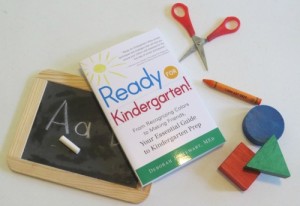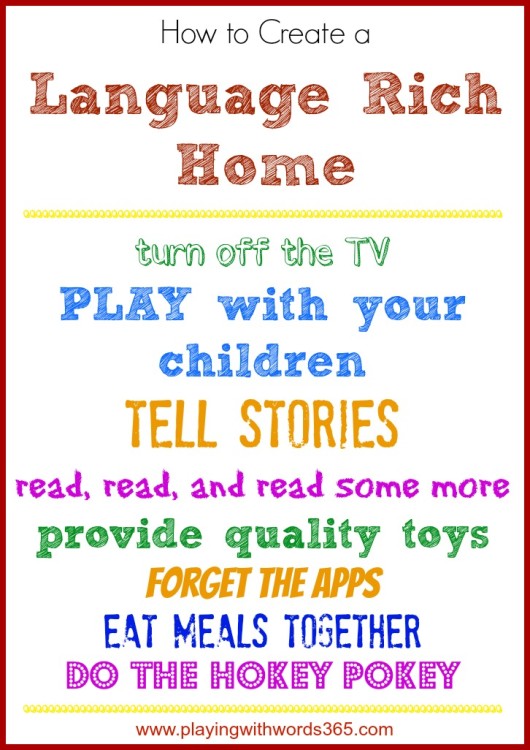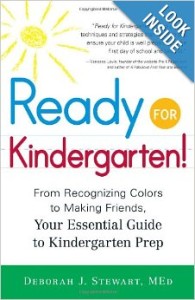Back before I started blogging, I was searching online for preschool activities and found this cool blog called Teach Preschool. One of the things I loved about the site, was that the activities provided were PLAY-BASED which if you know me at all, you know how important I believe play is to a child’s development. Deborah, Teach Preschool’s author, has recently published a book called Ready for Kindergarten! Deborah was kind enough to provide me with a copy of this great new book so that I could take part in a book study with several other early childhood bloggers. You can check out all the other Book Study posts on the Ready for Kindergarten page on Teach Preschool.
Disclaimer:Â I was provided a copy of this book by the author. All opinions are mine. This post contains affiliate links to Amazon.Â
About Ready for Kindergarten!
 As a speech pathologist, I am often asked by parents what they need to do to prepare their children for kindergarten. As a parent, I understand how much we want our kids to be as “ready” as possible for school. We all want our children to be confident learners and thrive in school. In her book Ready for Kindergarten!: From Recognizing Colors to Making Friends, Your Essential Guide to Kindergarten Prep, author Deborah J. Stewart, MEd, pulls from her over 20 years of experience working in early childhood education to bring you a book filled with tips to help prepare your little ones for that big step from preschool to kindergarten. This book covers many developmental areas including self-help, fine motor, gross motor, literacy, reading, writing, language and so much more. In each chapter, Deborah first explains the area of concern, what your child should know, and then how you can help expand his/her skills in that area to best prepare your child for kindergarten. This book is parent-friendly and though packed with lots of great information, is also an easy read.
As a speech pathologist, I am often asked by parents what they need to do to prepare their children for kindergarten. As a parent, I understand how much we want our kids to be as “ready” as possible for school. We all want our children to be confident learners and thrive in school. In her book Ready for Kindergarten!: From Recognizing Colors to Making Friends, Your Essential Guide to Kindergarten Prep, author Deborah J. Stewart, MEd, pulls from her over 20 years of experience working in early childhood education to bring you a book filled with tips to help prepare your little ones for that big step from preschool to kindergarten. This book covers many developmental areas including self-help, fine motor, gross motor, literacy, reading, writing, language and so much more. In each chapter, Deborah first explains the area of concern, what your child should know, and then how you can help expand his/her skills in that area to best prepare your child for kindergarten. This book is parent-friendly and though packed with lots of great information, is also an easy read.
The Book Study
For the book study, Deborah asked us to pick a chapter and provide the readers with an activity to help build the skills covered. I chose to highlight the chapter on Language (big surprise, huh??) and provide you all with some additional tips and activities to help create a language rich environment in your home. Chapter 15 is all about Language. Deborah mostly speaks about vocabulary in this chapter and gives some great suggestions on how to provide activities and outings in your child’s early years to help expose your child to more vocabulary. She also discusses how young children need to be able to use language to communicate their wants, needs, likes, dislikes, and ideas and provides some activities you can do at home to help promote your child’s language development. In addition to chapter 15, Deborah also discusses language in chapter 7: A Community of Learners in the Section I’m Talking to You. In this chapter  on page 104 she writes..
Developing the ability to communicate clearly and constructively is another important part of social development and kindergarten success. The ability to express her wants and needs verbally, to tell a story, to share ideas, to ask questions, will all be part of you child’s daily interactions with friends and her teacher.
Deborah gives some great ideas in this chapter to help engage your child in conversation at home to help expand his/her language and communication skills.
What is Language?
Before I go on, let’s review the definition of language. Here is an excerpt from my post What is the Difference Between Speech & Language:
While speech involves the physical motor ability to talk, language is a symbolic, rule governed system used to convey a message. In English, the symbols can be words, either spoken or written. We also have gestural symbols, like shrugging our shoulders to indicate “I don’t know†or waving to indicate “Bye Bye†or the raising of our eye brows to indicate that we are surprised by something. I like how ASHA, the American Speech Language Hearing Association, defines language: Language is made up of socially shared rules that include the following:
- What words mean (e.g., “star†can refer to a bright object in the night sky or a celebrity)
- How to make new words (e.g., friend, friendly, unfriendly)
- How to put words together (e.g., “Peg walked to the new store†rather than “Peg walk store newâ€)
- What word combinations are best in what situations (“Would you mind moving your foot?†could quickly change to “Get off my foot, please!†if the first request did not produce results)
Some of these “rule†systems that govern a language can include syntax, semantics, phonology, morphology, and pragmatics. You read can more about language in my post What is Language.
How to Create a Language Rich Environment in Your Home
Enriching your child’s receptive and expressive language development may sound scary, but believe it or not you can do it! Here are my tips for how to create a language rich environment in your own home:

- Read, read, and then read some more! Make sure you are reading books that your children really enjoy. Include books that incorporate repetition and rhyme. Read often and read with enthusiasm! Make up voices and have FUN!
- Turn off the TV. If you are home during the day, leave the TV off…don’t leave it on as background noise.  Studies have linked background TV noise to “lower sustained attention during playtime, lower quality parent-child interactions, and reduced performance on cognitive tasks.” So leave it off.
- Forget the Apps. Apps and TV have a time and a place, but language and communication is a human act. Your child will learn language and communication by interacting with people, not with apps or TV characters.
- Discuss the shows they do watch: There are some fun and educational shows out there for kids. My kids LOVE Octonauts, and have learned a lot about ocean life because of that show. I encourage you to discuss the show with your child. Ask them questions and start a dialogue about the topics. You can even research beyond the show to learn more about a specific subject. You can go on the computer together and learn more…keep the conversations going!
- PLAY! Play with your children. As in get down on the floor, grab some toys, and PLAY! Talk, narrate, and engage in play with your child. Follow their lead, play what they play, and have FUN.
- Provide quality toys that provide opportunities for open ended play. Toss the flash cards and the noisy “educational” toys that light up and sing and provide your children with quality toys that provide opportunities for open ended play. Read more about my thoughts on toys and my recommendations HERE.
- Do the Hokey Pokey, AKA sing! Little ones love songs that incorporate movement, which are also great for speech & language development, so do the hokey pokey and turn yourself about! Sing a variety of kids songs, sing your favorite top 40 hit, just make sure to sing often!
- Eat meals together. With the TV off. This alone should instigate some conversation. Discuss plans for the day if it is breakfast, or discuss what happened that day in the evening. A tip: Rather than ask “What did you do at school today?” (which can often get you no where), try asking if they did specific things (like art, sandbox, story time) and then have them tell you about those times. For my 4 year old, saying “Tell me three things you did today” gets her started!
- Tell Stories. At bedtime, try doing some story telling activities instead of reading books once or twice a week. You can use story telling visuals like the Tell Tale cards. For more tips on teaching your child storytelling skills, check out fellow SLP Katie’s post about it on her blog Let’s Grow Speech.
- Play language games like I Spy. These little games you might use in the car to pass the time are AWESOME for building language skills. Check out my post at Love That Max for some other “car” games that you can really play anytime.
- Play listening games like Simon Says. A HUGE part of kindergarten is following directions and this is an area you can have fun working on at home by playing games that support listening and following directions. Check out my post Five Playful ways to Work on Listening & Following Directions.
Get YOUR Child Ready for Kindergarten!
 Looking for more ways to get YOUR child ready for Kindergarten? Check out the other bloggers’ activities to go along with Ready for Kindergarten!: From Recognizing Colors to Making Friends, Your Essential Guide to Kindergarten Prep at Teach Preschool or if you are interested in the book, you can pick up a copy at Amazon.
Looking for more ways to get YOUR child ready for Kindergarten? Check out the other bloggers’ activities to go along with Ready for Kindergarten!: From Recognizing Colors to Making Friends, Your Essential Guide to Kindergarten Prep at Teach Preschool or if you are interested in the book, you can pick up a copy at Amazon.
What are YOUR tips for getting children ready for kindergarten?
Well said!! This looks like it is going to be an amazing resource for parents!!
I love this post Katie! I have just done one on school readiness which I will be posting next week and this works so well with it..